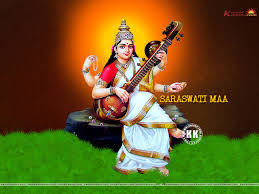Vedantam for Beginners -1: 16 & 17.
19/10/2018
16.Samadhi
Samadhi is the Turiya or the Fourth State which is Pure Consciousness or the Supreme Absolute where even a tinge of dual consciousness does not exist.
Raja Yogis practise Nirodha-Samadhi. Jnana Yogis or Vedantins practise Badha-Samadhi. In the practice of Nirodha-Samadhi the Raja Yogi stops all the Vrittis of the mind by concentrating on one form. In the practice of Badha-Samadhi the Jnana Yogi abandons all names and forms and takes up the one essence viz., Sat-Chit-Ananda Brahman that is the substratum for all these names and forms. There is Vyapakata in the Sadhana of a Jnana Yogi. He does Sadhana even while walking. Wherever he sees he tries to see the one underlying essence and rejects the names and forms. He is in Sahaja-Samadhi even while moving. But, a Raja Yogi sits and meditates. He is in need of a steady, definite pose. He cannot be in Samadhi while walking or moving.
In Vedanta, meditation is termed as Nididhyasana. Nididhyasana leads to Sakshatkara or Nirvikalpa Samadhi. One who has experienced Nirvikalpa Samadhi will not return to the state of embodiment once again.
17. Method Of Vedantic Sadhana
Sravana, Manana and Nididhyasana are the three stages of Vedantic Sadhana.
Sravana is hearing of the Truth. The Abheda-Bodha-Vakya should be heard from the Brahmanishtha-Guru. Then Vedantic scriptures and treatises have to be carefully studied for the purpose of properly grasping the meaning of the great Mahavakyas.
Vedantic Granthas are of two kinds: the Pramana-granthas and the Prameya-granthas. One should always study standard works on Vedanta. A complete and exhaustive treatise on the subject has to be studied with the greatest care. Then only the full knowledge of Vedanta will dawn. Works like the Advaitasiddhi, Chitsukhi, Khandanakhandakhadya, Brahmasutras, etc., are Pramana-granthas, for they refute other theories and establish the Advaita-Tattva through logic and argumentation. Works like the Upanishads, the Bhagavadgita and the Yogavasishtha are Prameya-granthas, for they merely state the Absolute Truth with authority and do not indulge in reasoning for refuting or establishing anything. They are intuitional works, whereas the former are intellectual.
The mind should be pure and tranquil before starting Vedantic Sadhana. Keeping the Vasana in the mind is keeping a black cobra within and feeding it with milk. Your life is ever in danger. Kill these Vasanas through Vichara, Vairagya and meditation on the Atman.
The Sruti texts that deal with creation, such as “From the Atman sprang Akasa, from Akasa Vayu, from Vayu Agni,” etc., are only intended for giving preliminary instructions to the neophytes or young aspirants; for they cannot grasp at once the Ajativada or the theory of non-evolution. When you read the passages which treat of creation, always remember that all this is only Adhyaropa or superimposition. Never forget this. Never think even for a second that the world is real. Only through Apavadayukti or refutation of superimposition can you establish the Kevala-Advaita-Siddhanta. If the world is real, if duality is real, you cannot have experience of Advaitic Realisation.
If the impurity of egoism or Ahamkara-Mala is destroyed, the other two impurities, viz., Kama-Mala (impurity of desire) and Karma-Mala (impurity of actions) will be destroyed by themselves. How, then, can there be Prarabdha for a Jivanmukta or the liberated sage? He is one with the Supreme Absolute.
NEXT - 18. Obstacles In Vedantic Sadhana
To be continued ..




.jpg)
Comments